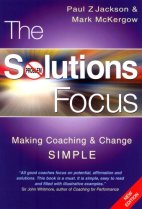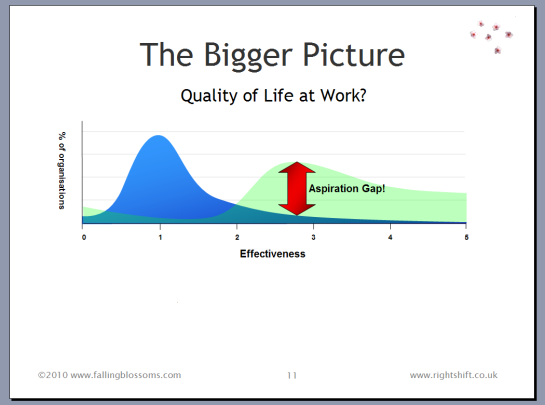Rightshifting and the Senior Management Pitch
[From the Archive: Originally posted at Amplify.com Nov 21, 2010]
Introduction
A number of folks have said to me recently that although Rightshifting strikes a chord with them personally, it’s their senior management that really needs to hear the message.
Few indeed are the organisations where ideas from the rank-and-file are taken seriously by the senior management. It’s almost as if these senior people are conditioned to automatically discount anything said to them by their “minions”. Maybe that’s one reason why consultants seem to have more success in bringing ideas to the attention of decision-makers.
I’ve been using “Value Forward Selling” for some years now as a means to engage with decision-makers, and a key technique in Value Forward Selling is something the originator – Paul DiModica – calls “The Three Box Monty”.
Not that I’m suggesting technical folks start learning how to sell ideas to management – that could be a whole new career! And most software people I know prefer to get on with the job at hand, rather than spend time and effort on “politics” and the like. Whether that’s a productive perspective or not is a different question, and maybe one for a different post.
Aside: There are a number of people in the Rightshifting community, myself included, that can help practitioners build and present a *tailored* case for more effective software development to their decision-makers. Go ahead, don’t be shy, ask for help and advice – that’s one of the reasons the Rightshifting community is here!
So, let’s take a closer look at the Three Box Monty, and why approaching it from a Solutions Focus perspective makes it even more powerful than the original technique.
The Three Box Monty Explained
The justification for the Three Box Monty is the observation that executives relate best to people they trust, and an effective means to build mutual trust is to establish a peer-to-peer relationship. Simply put, people listen more to and are more open to advice from people like themselves (“Business Peers”).
The Three Box Monty helps build that kind of mutual trust and peer-respect in a quick and simple fashion (i.e. during a thirty-minute to one-hour presentation).
So what is a Three Box Monty?
A Three Box Monty is a presentation technique using three boxes drawn on a Whiteboard or Flip chart:
BoxA Box B
BoxC
The Three Box Monty serves to position the presenter (typically, a sales person, coach, consultant, etc.) as a peer of the decision-makers in the audience. (An audience might generally consist of five to fifteen people, including decision-makers and members of their respective staffs).
The three boxes of the Three Box Monty are:
- Box A: The general business issues (pain points and problems) that are addressed by the presenter’s idea, product, or service and faced by all organisations in the same line of business, or industry sector, as the organisation being presented-to.
- Box B: The specific business issues currently faced by the people in the audience (and their organisation).
- Box C: A short list of ways in which the presenter’s ideas, products or services will directly contribute to the reduction of the problems listed in boxes A and B – and thus to the organisation’s declared objectives.
The presenter starts a Three Box Monty by writing a list of known “industry-wide” issues or problems into box A. This helps establish “peer credentials”, credibility, a common frame of reference, early consensus, and a basis for tackling box B.
With some five to seven items in box A, the presenter then moves on to box B, listing two or three business issues or problems specific to and familiar to the audience. Most often, these will have been learned from earlier discussions with the organisation. After inviting the audience to validate and contribute more items to box B, the presenter moves on again to box C. In box C, the presenter lists key solutions to the issues already listed in boxes A and B. Box C both shows how those solutions will help the organisation reach its desired goals, and highlights the role of the presenter’s organisation in providing key elements of these solutions.
Note that there’s a lot more to an effective Three Box Monty presentation than this brief introduction covers. In particular, I have skipped some of its most powerful aspects, centred around the psychology and sociology of meetings. See the very excellent “Value Forward Selling” by Paul DiModica pp 190-220 for much more information and explanation.

So, the normal Three Box Monty as just described concentrates on *problems*. What is “Solutions Focus” and where does it come into the picture?
Solutions Focus and the Three Box Monty
Solutions Focus is an approach to coaching and positive change that’s finding increasing acceptance in the world of business. It’s based on the basic principle of “finding what works, and doing more of it”. Rather than spend time analysing the past and its problem, why not just head directly for a solution? I recommend reading the excellent book “The Solutions Focus” by Jackson andMcKergow if you want to find out why this is nowhere near as trite as it may at first sound.

I’m not going to go into the details of the effectiveness of a Solutions Focus approach, except to say that there are some number of case studies describing the remarkable results a Solutions Focus approach can deliver when applied to e.g. business change.
So, the three boxes for my modified “Solutions Focus Three Box Monty” looks like this:
- Box A: What the leading businesses in the industry do (well)
- Box B: Which of those things the audience’s business is also presently doing (well)
- Box C: Which other things the audience would like their business to do (well) in the future
Note here that the key point is to change the focus of the Three Box Monty technique from problems to solutions, from the very outset. This is, of course, similar to the generally thrust of my “Perspectives on Rightshifting” presentation.
But wait! There’s another variant for us to consider:
The “Outcomes Focus” Three Box Monty
This variant adds to the Solutions Focus Three Box Monty by replacing the focus on solutions with a focus on outcomes:
- Box A: What positive outcomes the leading businesses in the industry are seeing presently
- Box B: Which of those outcomes the audience’s business is also presently seeing (and maybe one or two where they’re ahead of the competition)
- Box C: Which other positive outcomes the audience would like their business to see in the future.
Note that here, in this alternate variant, which I’m calling “The Outcomes Focus Three Box Monty”, the key point is to focus on positive outcomes – both those already seen and those desired for the future – from the very outset.
I’d be happy to explain more, particularly about the psychology underpinning this approach, should anyone express an interest in this line of thought, or wish to begin using it to positive advantage in their own situation.
I’d also love to hear from anyone already doing stuff like this.
– Bob




